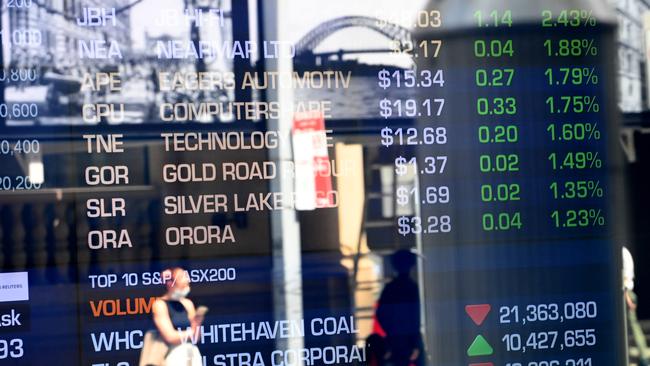Markets stall as Ukraine peace talks falter
After the strongest rebound in the global sharemarket since late 2020, a renewed jump in crude oil prices threatens to trigger another bout of risk aversion.

Business
Don't miss out on the headlines from Business. Followed categories will be added to My News.
Stagflation risk remains front and centre of concerns for global financial markets.
After the strongest rebound in the global sharemarket since late 2020, a renewed jump in crude oil prices threatens to trigger another bout of risk aversion in shares at the start of the week.
After surging almost 80 per cent this year, Brent crude oil futures hit a record high of $US139.13 a barrel two weeks ago after Russia’s invasion of Ukraine and Western sanctions on Russia – including a US ban on Russian crude oil and fuel imports. That stoked fear of a 1970s-style inflation shock and economic weakness as central banks and governments unwound pandemic-era stimulus.
The oil price fell 30 per cent to $US96.93 a barrel over the next seven days amid expectations that the sky-high pump prices would lead to increased supply and “demand destruction”, causing a 15 per cent bounce in the energy dependent European markets and a 7 per cent bounce in the S&P 500.
Australia’s sharemarket bounced a bit less because its commodities exposure led to significant outperformance versus global markets during their recent correction. However, it still managed to bounce as much as 5.3 per cent to a five-week high of 7350.4 points by the start of the week.
Overall, the technical picture had looked encouraging.
The Euro Stoxx 50 had formed a V-shaped bottom, and the S&P 500 and Nasdaq Composite tested their respective 50 and 200-day moving averages after bouncing off February lows and forming uptrends.
But with Ukraine-Russia peace hopes dented by Russia’s use of hypersonic missiles and Ukraine’s refusal to surrender Mariupol, Brent crude oil futures surged 3.5 per cent to $US111.75 a barrel in Asia-Pacific trading, sending US and European stock index futures down about 0.5 per cent.
The Australian market shied off its 200-day moving average at 7333 and its February peak at 7356.8 – potentially foreshadowing another lurch to the downside – and the S&P 500 and Nasdaq looked to be at risk of failing at their 50 and 200-day moving averages respectively.
Share trading volumes were light with Japanese markets closed for a public holiday.
However the recent sharp fall in the S&P 500 VIX volatility index to 23.87 per cent – which is likely to have caused some short covering by hedge funds and buying by risk parity funds – doesn’t seem sustainable while crude oil remains well north of $US100 a barrel and moving multiple dollars a day.
Investors awaited the outcome of talks overnight between US President Joe Biden and European leaders. As well as Biden’s call with the leaders of France, Germany, Italy and the UK, the White House planned to meet Exxon Mobil and JPMorgan executives on the impact of the invasion and sanctions. Federal Reserve chair Jay Powell was speaking to the National Association of Business Economists.
But Citi chief economist Andrew Hollenhorst cautioned that there was little reason to expect a significant decline in underlying inflation unless and until financial conditions “more meaningfully tighten”.
Conditions have tightened with the sell-off in shares and rise in bond yields, but two-year real yields are near historical lows and the S&P 500 had its best week since November 2020.
Mr Hollenhorst said the outcome of last week’s Fed meeting was “hawkish” in that “dots” now indicate seven 25 basis point rate hikes in 2022, at least one more than most expected and close to what the market was pricing, yet implied real rate projections fell as Fed median nominal policy rate forecasts were revised up about half as much as the jump in inflation forecasts.
“That means the Fed is now planning to set real policy rates at lower levels at the end of 2022 than they did in December, despite becoming more concerned about upside risk to inflation over the period,” he said.
“Intuitively, if nominal rates need to rise with inflation just to obtain the same level of real rates … (then) to lean against inflation real rates need to move higher, meaning nominal rates must be adjusted upward by more than inflation.”
Mr Hollenhorst expected balance sheet reduction to start in May with a 50 basis point hike at that meeting, and the chance of subsequent 50 basis point hikes was increasing as risks to higher inflation continued to build.
“The only comparable period of excessive inflation in the 1970s shows a similar pattern as today,” he said.
“Two-year yields increased steadily as the Fed raised policy rates, but not at a faster speed than inflation increased. That meant real yields stayed at very low levels. Only as two-year bond yields finally moved above inflation and real rates were held at positive levels did inflation cool off.”
After looking at the history of Fed rate hikes over the last 50 years, Wilsons’ David Cassidy found that while Fed tightening cycles did not inevitably lead to a recession, usually they did. Of the 10 hiking cycles he identified since 1970, there were six recessions and seven corresponding equity bear markets flowing off the back of Fed hiking campaigns.
The gap from the first hike to recession is typically long, with an average gap of just over three years, but the shortest gap between the first hike and the onset of a recession was just 12 months in the short-and-sharp 1980 hiking cycle as the Fed attempted to break the back of inflation.



